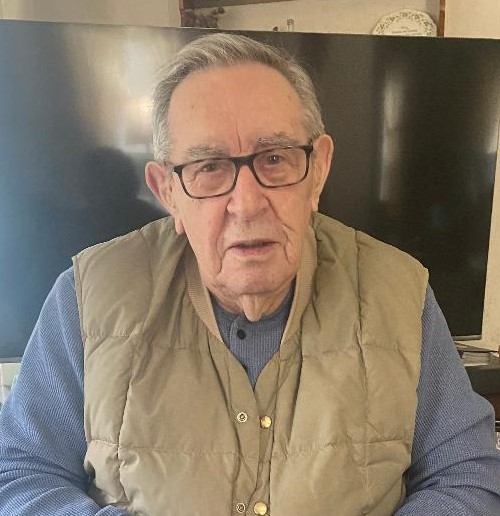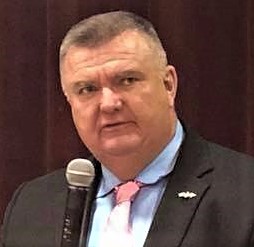By: John Cuddy – May, 2021
 Dracut’s Arthur Ducharme Sr. is a US Navy World War II Pacific Theater Veteran. He turned ninety-six on April 1st of this year. Arthur is the older brother of World War II Veteran, Joseph Alfred Ducharme, who served as a Military Police Officer at the Nuremburg trials in Germany and was featured last summer in the Valley Patriot.
Dracut’s Arthur Ducharme Sr. is a US Navy World War II Pacific Theater Veteran. He turned ninety-six on April 1st of this year. Arthur is the older brother of World War II Veteran, Joseph Alfred Ducharme, who served as a Military Police Officer at the Nuremburg trials in Germany and was featured last summer in the Valley Patriot.
Growing up in Pelham, New Hampshire, Arthur left school after completing the eighth grade to support his family, after his father died. His dad was electrocuted in an industrial accident, leaving behind a wife, four daughters and three sons. Arthur was the oldest at the time, and the burden fell on him, as a young teenager, to support the family, working at the American Woolen Company in Lawrence and Dracut, Massachusetts.
Like many of his generation, his life was altered by the Japanese attack on Pearl Harbor on December 7, 1941. Arthur joined the US Navy in March of 1943, reporting for training at the Sampson Naval Base in Romulus, New York. He contracted spinal meningitis while in Basic training, and nearly died. He was sent home for thirty days medical leave, then returned to finish basic training. After graduation, his entire training company was sent to Amphibious training at Little Creek, Virginia and Fort Pierce, Florida.
The wartime needs of the Navy, overrode any personal training desires. Half of Arthur’s Recruit Company were selected to be Radiomen, the other half to become Signalmen. The US Navy Radiomen were responsible for transmitting and receiving radio signals and processing all forms of telecommunications through various transmission media aboard ships, aircraft and at shore facilities. US Navy Signalmen were responsible for transmitting, receiving, encoding, decoding, and distributing messages obtained via the visual transmission systems of flag semaphore, visual Morse code, and flag hoist signaling.
With a two-ocean war waging against Germany, Italy, and Japan, the US Military put very little effort into finding out what a recruit’s educational background or aptitude was, the Greatest Generation simply learned the skills needed to defeat the Axis powers. After the war, Arthur learned that the other half of his US Navy Signalmen classmates, were shipped to the European Theater and participated in the invasion of Normandy.
Arthur found himself assigned to Beach Party 12, attached to a unit of US Army Engineers, at Camp Picket, Virginia. His team was sent by rail to Camp Stoneman, California, and embarked on a US Navy LST (Tank Landing Ship). It took the LST twelve days to sail from California to Hawaii. In Hawaii they were sent to a Troop Transport, the USS Ormsby, heading to invade Kwajalein Atoll.
The US Marines took the island after heavy fighting, and Beach Party Team 12 did not have to go ashore. The team rotated back to Hawaii for “rest and relaxation” (also known as R&R), then were loaded onto the USS Neville for the invasion of Saipan, in June of 1944, with the Second Marine Division. They landed at the south end of the island, so the Marines could capture a vital Japanese Airfield. Each night the ship moved out into deep water to bury the American dead at sea. After Saipan, it was back to Hawaii for two weeks R&R.
Arthur was assigned to a mine laying vessel, PCS-1379. “PCS” is short for Patrol Craft Mine Sweeper, Quincy, Massachusetts native Lieutenant E. U. O’Donnell USN-R was the commanding officer. With a crew of seventy, led by three US Navy Officers, the boat was very heavily armed for its small crew and size, with one .50 caliber machine gun, one 40 mm gun, two 20 mm guns, four depth charge projectors, one Hedgehog anti-submarine mortar, and two depth charge tracks. This formable array of weapons was crammed into a boat only 136’ long.
US Navy Signalman First Class Arthur Ducharme’s last battle was the invasion of Okinawa during April of 1945. The Japanese defended their home islands with deadly Kamikaze planes and subs. After the invasion of Okinawa, (on Arthur’s birthday April 1, 1945) the island was secured on June 21, 1945. Arthur was sent back to Hawaii for two weeks R&R. After President Harry Truman dropped the second atomic bomb on Nagasaki, and Japan surrendered, Arthur having seven dependents, a mother and seven siblings, was one of the first servicemen in the Pacific Theater to be demobilized.
After the war, Arthur worked for Merrimack MFG, making velvet. He then joined the staff of the now University of Massachusetts at Lowell, Massachusetts, working as a watchman, Campus Police officer, and finally retiring as the school’s carpenter. He and his wife Mildred were married fifty-nine years, she died at the age of eighty-four. The couple has four children, seven grandchildren, and five great grandchildren. Truly a “Hero in Our Midst”!
The Dracut American Legion asks all World War II, Korean War, and Vietnam War Veterans, to call (603) 518-5368 and sign up for an Honor Flight to the Memorials in Washington DC! Veterans of all eras are asked to go the American Legion’s Web site www.legion.org, and join the American Legion, preserving our Veteran’s Benefits for future generations.

John Cuddy served in the US Navy’s Construction Battalions (also known as the Seabees) after retiring from the Navy; he earned a bachelor’s in history and a master’s in economics from the University of Massachusetts on the Lowell Campus. He has been employed in Logistics at FedEx for the last 24 years. If you know a World War II veteran who would like their story told, please email him at John.Cuddy@Yahoo.com. ◊
